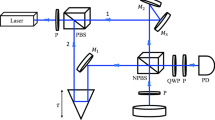Abstract
We investigate the discrimination between photon polarizations when measured by moving detectors. Both unambiguous and minimum-error discriminations are considered, and we analyze the the optimal successful (correct) probability as a function of the apparatus’ velocity. The Holevo bound for polarization discrimination is also discussed and explicit calculation shows that the Holevo bound and the optimal successful (correct) probability for unambiguous (minimum-error) discrimination simultaneously increase or decrease.
Similar content being viewed by others
Explore related subjects
Discover the latest articles, news and stories from top researchers in related subjects.References
Helstrom C.W.: Quantum Detection and Estimation Theory. Academic, New York (1976)
Holevo A.S.: Statistical decision theory for quantum systems. J. Multivar. Anal. 3, 337 (1973)
Yuen H.P., Kennedy R.S., Lax M.: Optimum testing of multiple hypotheses in quantum detection theory. IEEE Trans. Inf. Theory IT 21, 125 (1975)
Barnett S.M.: Minimum-error discrimination between multiply symmetric states. Phys. Rev. A 64, 030303(R) (2001)
Andersson E., Barnett S.M., Gilson C.R., Hunter K.: Minimum-error discrimination between three mirror-symmetric states. Phys. Rev. 65, 052308 (2002)
Chou C.L., Hsu L.Y.: Minimum-error discrimination between symmetric mixed quantum states. Phys. Rev. A 68, 042305 (2003)
Herzog U., Bergou J.A.: Minimum-error discrimination between subsets of linearly dependent quantum states. Phys. Rev. A 65, 050305(R) (2002)
Dieks D.: Overlap and distinguishability of quantum states. Phys. Lett. A 126, 303 (1998)
Ivanovic I.D.: How to differentiate between non-orthogonal states. Phys. Lett. A 123, 257 (1987)
Peres A.: How to differentiate between non-orthogonal states. Phys. Lett. A 128, 19 (1998)
Jaeger G., Shimony A.: Optimal distinction between two non-orthogonal quantum states. Phys. Lett. A 197, 83 (1995)
Chefles A.: Unambiguous discrimination between linearly independent quantum states. Phys. Lett. A 239, 339 (1998)
Peres A., Terno D.R.: Optimal distinction between non-orthogonal quantum states. J. Phys. A 31, 7105 (1998)
Duan L.M., Guo G.C.: Probabilistic cloning and identification of linearly independent quantum states. Phys. Rev. Lett. 80, 4999 (1998)
Sun Y., Hillery M., Bergou J.A.: Optimum unambiguous discrimination between linearly independent nonorthogonal quantum states and its optical realization. Phys. Rev. A 64, 022311 (2001)
Chefles A., Barnett S.M.: Optimum unambiguous discrimination between linearly independent symmetric states. Phys. Lett. A 250, 223 (1998)
Jiménez O., Sánchez-Lozano X., Burgos-Inostroza E., Delgado A., Saavedra C.: Experimental scheme for unambiguous discrimination of linearly independent symmetric states. Phys. Rev. A 76, 062107 (2007)
Jafarizadeh M.A., Rezaei M., Karim N., Amiri A.R.: Optimal unambiguous discrimination of quantum states. Phys. Rev. A 77, 042314 (2008)
Wu X., Yu S., Zhou T.: One-photon interferometer for realizing optimal unambiguous discrimination among quantum subsets. Phys. Rev. A 79, 052302 (2009)
Zhou, T.: Unambiguous discrimination between two unknown qudit states. Quantum Int. Process. doi:10.1007/s11128-011-0327-x
Aspelmeyer M. et al.: Long-distance free-space distribution of quantum entanglement. Science 301, 621 (2003)
Resch K.J. et al.: Distributing entanglement and single photons through an intra-city, free-space quantum channel. Opt. Express 13, 202 (2005)
Ursin R. et al.: Entanglement-based quantum communication over 144 km. Nat. Phys. 3, 481 (2007)
Fedrizzi A., Ursin R., Herbst T., Nespoli M., Prevedel R., Scheidl T., Tiefenbacher F., Jannewein T., Zeilinger A.: High-fidelity transmission of entanglement over a high-loss free-space channel. Nat. Phys. 5, 389 (2009)
Peres A., Terno D.R.: Relativistic Doppler effect in quantum communication. J. Mod. Opt. 50, 1165 (2003)
Gingrich R.M., Bergou A.J., Adami C.: Entangled light in moving frames. Phys. Rev. A 68, 042102 (2003)
Wigner E.: On unitary representations of the inhomogeneous lorentz group. Ann. Math. 40, 149 (1939)
Weinberg S.: The quantum theory of Fields, Vol. 1. Cambridge University Press, Cambridge (1996)
Mandel L., Wolf E.: Optical coherence and quantum optics. Cambrige University Press, Cambrige (1995)
Nielson M.A., Chuang I.L.: Quantum computation and quantum information. Cambridge University Press, Cambridge (2000)
Peres A., Scudo P.F., Terno D.R.: Quantum entropy and special relativity. Phys. Rev. Lett. 88, 230402 (2002)
Peres A., Terno D.R.: Quantum information and relativity theory. Rev. Mod. Phys. 76, 93 (2004)
Author information
Authors and Affiliations
Corresponding author
Rights and permissions
About this article
Cite this article
Zhou, T., Cui, J. & Cao, Y. Influence of detector motion on discrimination between photon polarizations. Quantum Inf Process 12, 747–759 (2013). https://doi.org/10.1007/s11128-012-0416-5
Received:
Accepted:
Published:
Issue Date:
DOI: https://doi.org/10.1007/s11128-012-0416-5





